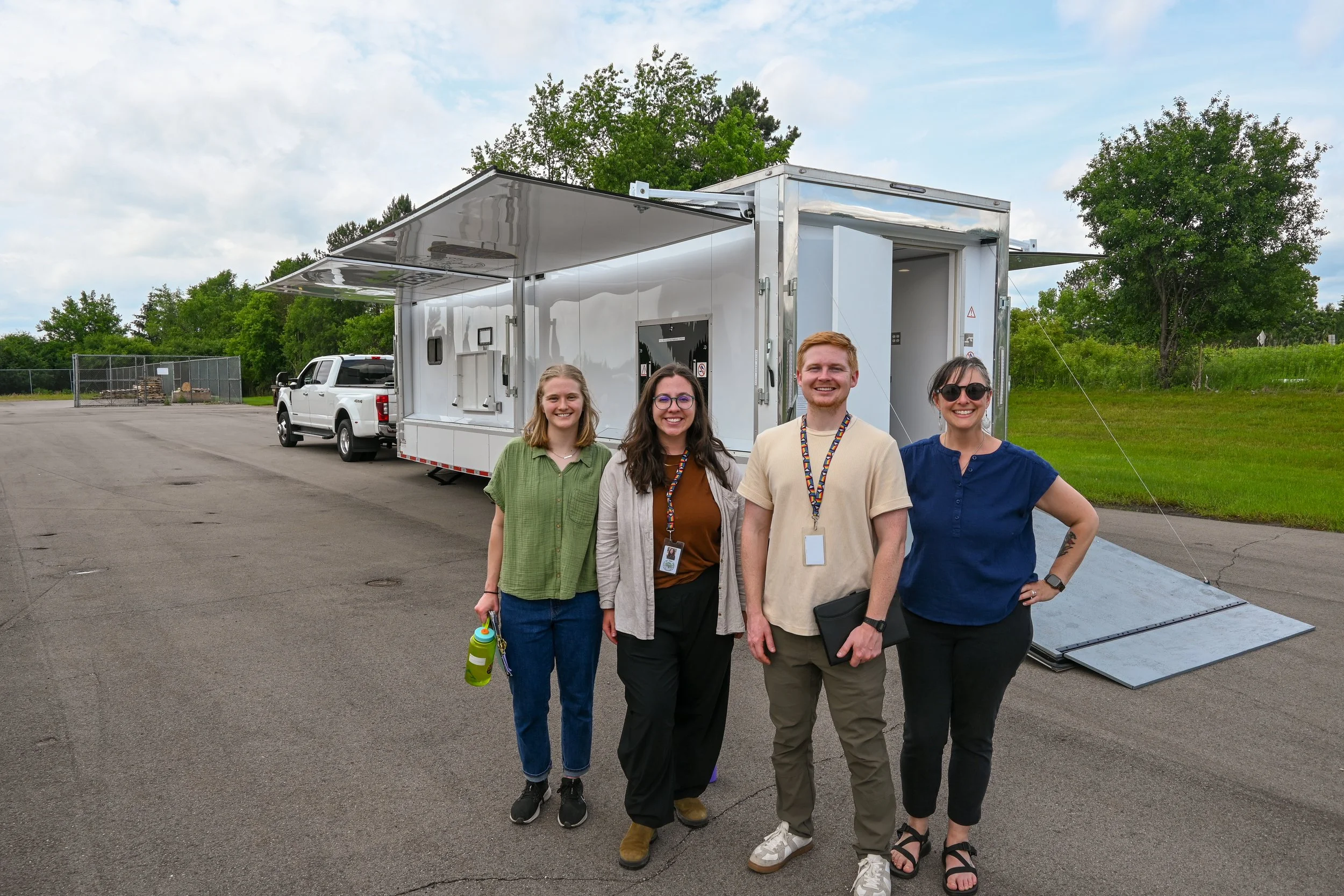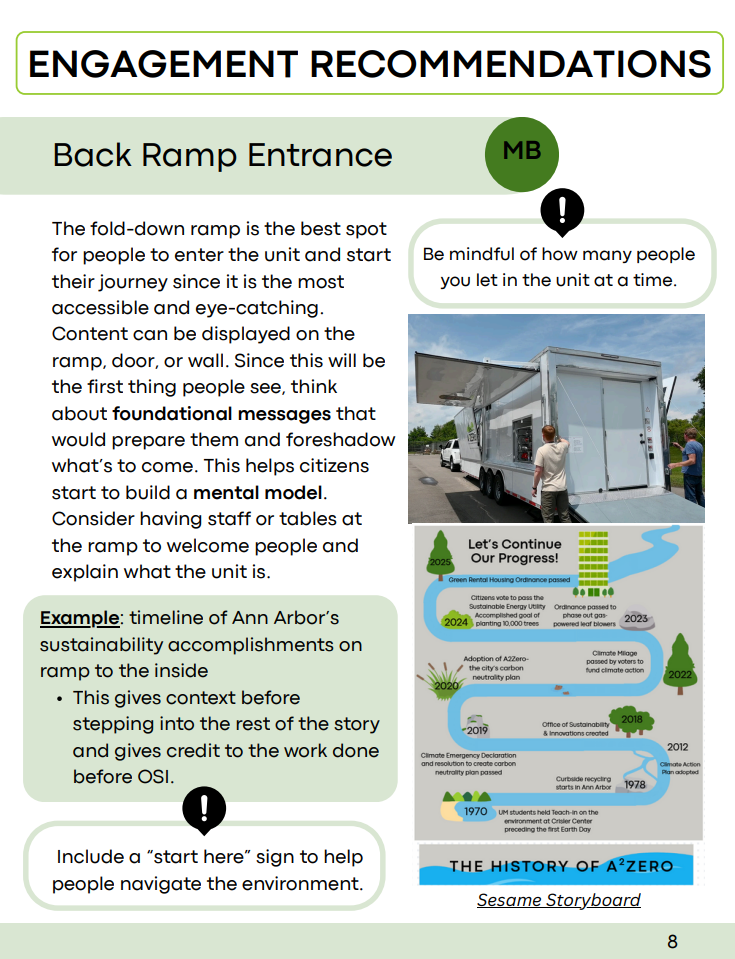Using the SEE Framework for Creative Community Engagement
This summer, I worked with Ann Arbor’s Office of Sustainability & Innovations (OSI) as a reDirect fellow, helping them implement the Supportive Environments for Effectiveness (SEE) framework in a community engagement initiative. The City recently acquired a mobile nanogrid (called a Sesame Solar Unit) to use as an adaptable teaching tool, telling the story of OSI’s work to reach carbon neutrality by 2030. Working with Bryce Frohlich, a Community Resilience Specialist with OSI, I created a guide to help OSI staff effectively use the different spaces of the unit to educate citizens about more sustainable living.
Meredith (far left) with her OSI colleagues in front of the Sesame Solar unit.
The Sesame unit is outfitted with solar panels and a hydrogen fuel cell to produce clean off-grid energy. That energy is stored in eight in-unit batteries and can be used for emergency services or for powering street festivals and community events. The physical features of the entire unit present opportunities for creating learning zones. For example, there is a small lab space inside with fold-out desks and computer monitors that functions like a mini classroom. Plus, all the walls, both interior and exterior, are covered with a white-board surface that can be used for creative displays and group activities.
After acquiring the unit, the team established that one of the main project goals was to close the gap between people receiving information and taking action. Instead of getting bogged down with why people should live sustainably, we wanted to teach the public how to live more sustainably. In other words, we wanted to facilitate the type of understanding that’s focused on practical application, which is sometimes referred to as procedural knowledge.
The SEE framework suggests that humans are action-oriented and seek clarity, so providing procedural knowledge helps meet our informational needs. In that way, our OSI team wanted people to know how to get involved in sustainability work instead of just providing more information about a topic like energy efficiency or circularity.
When creating the engagement guide for OSI staff, I encouraged them to start by identifying their main goal and the procedural knowledge they would like to communicate first. Then, they could work backwards to design specific content like games, posters, or simulations to support that goal.
A visit to the Sesame unit would include clearly outlined next steps that citizens could take to make a difference, which correlates with a key SEE tenet: meaningful engagement. Some of these actions could include subscribing to OSI’s newsletter, scheduling a Home Energy Assessment, or participating in monthly clothing swaps.
With procedural knowledge and meaningful engagement as guiding principles, my engagement guide divided the physical spaces of the Sesame unit into different areas and provided OSI staff with advice on how to use each one. For example, the entrance of the unit is narrow, so we needed to make sure that people would not get stuck in a bottleneck, especially at busy events. Therefore, I recommended that staff focus on the flow and sequencing of information, in relation to the context of the physical space, and, within the storyline of their visit. This would make the physical navigation of the unit easier, and, by focusing on foundational messages early on, such as OSI’s overall goals, guests would be able to develop a mental model of sustainability before getting into more specific details. QR codes could also be strategically displayed, allowing viewers to explore more information at their own pace, while keeping the primary information light and easy to understand.
When guests exit the unit, the focus would turn toward outlining next steps. At that point, citizens would have begun to create a mental model and should feel inspired and motivated, so it’s the right stage in the journey to offer specific calls-to-action.
Let’s look at a hypothetical example of how OSI could use the various spaces of the Sesame to take guests on an educational journey. Suppose they want to feature it at Ann Arbor’s local food festival. Using the exterior TV monitors, they could show a short documentary about a farmer along with a question on the whiteboard walls, such as “What does ‘local’ mean to you?” The question would invite people to write down their reflections and begin to think about where their food comes from. Inside the unit, there could be informational posters about the environmental benefits of shopping locally, and a map where participants could calculate the number of miles between where they live and where their food is grown. As they conclude their journey, they would receive a flyer with information on community gardens and farmer’s market hours so they could start to take action. Meanwhile, all of this would be happening while the Sesame provides the festival with clean power instead of using diesel generators.
Example page from OSI’s Sesame Solar unit engagement guide using color coding and call out boxes for clarity.
Finally, I also used the SEE framework to inform specific graphic design choices in the document. For instance, I color-coded each section of the guide so that readers could develop a mental model from information that was presented in clear chunks. Call-out boxes were also used to highlight important information and prevent attentional fatigue, which can happen when important details are hidden within dense paragraphs. These strategies increase the likelihood that OSI staff will use the guide and implement effective engagement activities.
I had an amazing experience as a reDirect fellow because I got to see firsthand how the real-world application of theoretical frameworks can make a big difference in the outcome of a project. It was also exciting to see OSI staff members learn about the SEE framework and begin to understand it. Taking time to think about how humans best process information was valuable internally for OSI staff and externally for Ann Arbor citizens. Additionally, it helped me navigate the seas of possibility that the Sesame Solar unit offered.


